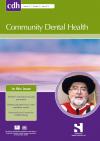Community Dental Health

- Cover Date:
- June 2015
- Print ISSN:
- 0265 539X
- Vol:
- 32
- Issue:
- 2
Editorial
© BASCD 2015 doi:10.1922/CDH_Levine02
Editorial
Advancing the scientific basis of oral health education
Ronnie Levine
One of the greatest barriers to encouraging and enabling individuals to take greater control over their own health is confusing and sometimes conflicting health messages, occasionally in the media but sometimes from professional sources and advisors. The problem for dental health education had become apparent by the 1970s and was approached in the UK by the Health Education Council who organized a seminar in 1971 to consider the scientific evidence supporting dental health education messages. A further review of the evidence was being planned in 1976 when it was learned that the British Association for the Study of Community Dentistry was also developing a similar approach. This led to a joint initiative aimed at establishing a scientific basis for dental health education to help standardise the advice given to the public and to ensure that such advice was scientifically sound. The initiative took the form of a seminar at which a group of dental scientists actively engaged in research presented position papers on the cause and prevention of periodontal disease and caries to a group of leading experts and authorities in preventive dentistry. These position papers and the discussion that followed were then edited into a final document by Michael Lennon, the present editor of this journal. In 1976 the document was published by the Health Education Council with the title - The Scientific Basis of Dental Health Education, a policy document. It was a slim document with a green cover. Following an introduction by Philip Holloway from the University of Manchester, the second section of the document covered the cause and prevention of periodontal diseases while the third section covered the cause and prevention of dental caries. The summary provided three simple messages - insist on fluoridation, restrict sugar-containing foods and drinks to meal times and clean the teeth and gums thoroughly every day with a fluoride toothpaste. The whole text occupied only 12 pages. The strength of the original document was that it came from an independent and authoritative source and was based on the proceedings of a consensus meeting of a group of the leading dental experts of the day. As the value of the document became apparent the Heath Education Council commissioned a second edition for which the present author agreed to take responsibility and it appeared in 1982.
- Article Price
- £15.00
- Institution Article Price
- £
- Page Start
- 66
- Page End
- 67
- Authors
- Ronnie Levine
Articles from this issue
- Title
- Pg. Start
- Pg. End
- Dentists’ knowledge of oral health during pregnancy: a review of the last 10 years’ publications
- 77
- 82
- A pilot project to improve the oral health of orphans and of the elderly in residential care in Constanta, Romania
- 89
- 92
- The association between parents’ perceived social norms for toothbrushing and the frequency with which they report brushing their child’s teeth
- 98
- 103
- Are Stage of Change constructs relevant for subjective oral health in a vulnerable population?
- 111
- 116
